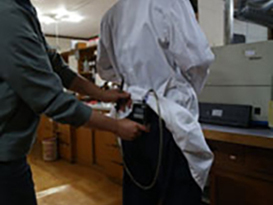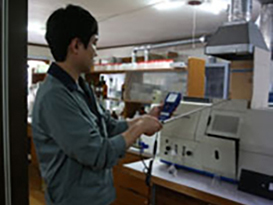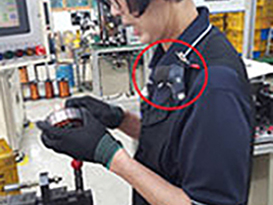Working environment measurement
Purpose of Working environment measurement
- After measuring and assessing how much workers are exposed to harmful factors such as noise, dust, and harmful chemicals that occur during work, a clean working environment is created through proper improvement of facilities, then it contributes to the health protection and productivity improvement of workers
Working environment measurement
-
To protect the health of workers from harmful factors and create a pleasant working environment, the owner shall record and preserve the results and report the results to the Minister of Employment and Labor as provided by the Employment and Labor Ministerial ordinance. In such a case, the representative of the workers shall be present when measuring the work environment as required..
The owner shall notify the results of the work environment measurement to the workers and take appropriate measures, such as installing, improving facility, or conducting a health examination, to protect the health of the workers.
Target workplace of working environment measurement
-
This refers to a workplace where workers are exposed to harmful factors of work environment measurement in Annex 11, 5 of the Enforcement Rules of the Industrial Safety and Health Act. However, the working environment may not be measured if any of the following:
1. Temporary work (a temporary work that is performed on a temporary basis is less than 24 hours per month. However, Excludes jobs that are performed monthly for more than 10 hours and less than 24 hours per month) and short-term work sites (except for handling materials that are designated by the Minister of Employment and Labor).
2. Workplace not exceeding allowable consumption of hazardous substances(only for work environment measurement of hazardous substances
3. Excluded workplace with dust work(only for work environment measurement of dust
4. In addition, the level of exposure of hazardous factors in the work environment is significantly lower than the standard of exposure, which is determined by the Minister of Employment and Labor. - In the case that a health institution conducts a health examination, When the work environment is measured in accordance with the methods provided by the Minister of Employment and Labor for all harmful factors in the workplace pursuant to Clause 1, the owner may not measure the work environment of the workplace to be performed in the measurement cycle according to Article 42 of the Act.
Measurement cycle of work environment measurers
- If a workplace becomes a work environment subject to measurement, such as a new operation or change of work process, the work environment shall be measured within 30 days from that date, and the work environment shall be measured regularly at least once every six months thereafter.
| ※ Change the measurement period if: | |
|---|---|
| More than once every three months | In case the carcinogenic substance exceeds the exposure standard or the measurement exceeds more than 2 times of the standard. |
| More than once a year | In case there have been no changes affecting the results of the work environment measurement, such as changes in the process facilities, the method of work, the transfer of the facilities, or changes in the chemicals used (excluding the process for the treatment of carcinogens)) |
Hazardous Factors Subjected to Work Environment Measurements자
- 1. Chemical factor
- Organic compounds (113 types
-
1) Glutaraldehyde
2) Nitroglycerin
3) Nitromethane
4) Nitrobenzene
5) p-Nitroaniline
6) p-Nitrochlorobenzene
7) Dinitrotoluene
8) Dimethylaniline, N,N-Dimethylaniline
9) Dimethylamine
10) N,N-Dimethylacetamide
11) Dimethylformamide
12) Diethanolamine
13) Diethylene triamine
14) 2-Diethylaminoethanol
15) Diethyl ether
16) Diethylamine
17) 1,4-Dioxane, Diethyl dioxide
18) Diisobutylketone
19) Dichloromethane
20) o-Dichlorobenzene
21) 1,2-Dichloroethylene
22) Dichlorofluoromethane
23) 1,1-Dichloro-1-fluoroethane
24) Dihydroybenzene
25) 2-Methoxyethanol: EGME
26) 4,4'-Methylene di(bis)phenyl diisocyanate
27) Methyl amine
28) Methyl alcohol
29) Methyl ethyl ketone
30) Methyl isobutyl ketone
31) Methyl chloride
32) Methyl n-butyl ketone
33) Methyl n-amyl ketone
34) o-Methyl cyclohexanone
35) Methyl cylohexanol
36) Methyl chloroform
37) Maleic anhydride
38) Phthalic anhydride
39) Benzene
40) 1,3-Butadiene
41) sec-Butyl alcohol
42) n-Butyl alcohol
43) 1-Bromopropane
44) 2-Bromopropane
45) Methyl bromide
46) Vinyl acetate
47) Carbon tetrachloride
48) Styrene
49) Cyclohexanone
50) Cyclohexanol
51) Cyclohexane
52) Cyclohexene
53) Aniline & homologues
54) Acetonitrile
55) Acetone
56) Acetaldehyde
57) Acrylonitrile
58) Acrylamide
59) Allylglycidylether
60) Ethanolamine
61) Ethylbenzene
62) Ethylamine
63) Ethyl acrylate
64) Ethylene glycol dinitrate
65) 2-Methoxyethyl acetate, EGMEA
66) 2-Ethoxy ethanol, EGEE
67) 2-Ethoxyethylacetate, EGEEA
68)(2-Butoxyethanol, EGBE
69) Ethylene glycol mono butyl acetate
70) Ethylene glycol
71) Ethylene chlorohydrin
72) Ethyleneimine
73) 2,3-Expoxy-1-propanol
74) 1,2-Epoxypropane
75) Epichlorohydrin
76) Methyl iodide
77) Isobutyl alcohol
78) Isoamyl alcohol
79) Isopropyl alcohol
80) Ethylene dichloride
81) Carbon disulfide
82) Methyl acetate
83) n-Butyl acetate
84) Ethyl acetate
85) n-Propyl acetate
86) Isobutyl acetate
87) Isopropyl acetate
88) Isoamyl acetate
89) Cresol, all isomers
90) Xylene, o,m,p-isomers
91) Chlorobenzene
92) 1,1,2,2-Tetrachloroethane
93) 1,1,2-Trichloroethane
94) 1,2,3-Trichloropropane
95) Tetrahydrofuran
96) Toluene
97) Toluene-2,4-diisocyanate
98) Toluene-2,6-diisocyanate
99) Triethylamine
100) Trichloromethane
101) Trichloroethylene
102) Perchloroethylene
103) Phenol
104) Pentachlorophenol
105) Formaldehyde
106) Stoddard solvent
107) Propylene imine
108) Pyridine
109) Hydrazine
110) Hexamethylene diisocyanate
111) Hexane, n-Hexane
112) Heptane, n-Heptane
113) Dimethylsulfate
114) A preparation containing 1% or more of the substances from 1) to 113).
- Metals (23 types)
-
1) Copper
A) Fume
B) Dusts and Mists, as Cu
2) Lead and inorganic compounds, as Pb
3) Nickel, as Ni
A) Element
B) Soluble inorganic compounds
C) Insoluble inorganic compounds
D) Nickel carbonyl
4) Manganese and inorganic compounds, as Mn
5) Barium and soluble compounds, as Ba
6) Platinum
A) Metal
B) Soluble salts
7) Magnesium oxide
8) Selenium and compounds, as Se
9) Mercury, as Hg
A) Alkyl compounds) B) Aryl compounds
C) Element and inorganic forms
10) Zinc oxide
A) Fume
B) Dust
11) Antimony and compounds, as Sb
12) Aluminum and compounds, as Al
A) Metal Dust
B) Pyro powders
C) Fume
D) Soluble salts
E) Alkyl, NOS
13) Iodine
14) Silver
A) Metal
B) Soluble compounds, as Ag
15) Titanium dioxide
16) Tin, as Sn
A) Metal
B) Oxide & inorganic compounds, except tin hydride
C) Organic compounds
17) Zirconium and compounds, as Zr
18) Iron oxide dust and fume, as Fe
19) (Cadmium and compounds, Cd
20) Cobalt and inorganic compounds, as Co
21) Chromium and inorganic compounds, as Cr
A) Metal and Cr Ⅲ compounds
B) Water soluble Cr Ⅵ compounds
C) Insoluble Cr Ⅵ compounds
22) Tungsten, as W
A) Metal and insoluble compounds
B) Soluble compounds
23) Vanadium pentoxide
A) Dust and fume
24) A preparation containing 1% or more of the substances from 1) to 23)
- Acid and alkaline (17 types)
-
1) Formic acid
2) Hydrogen peroxide
3) Acetic anhydride
4) Hydrogen fluoride
5) Hydrogen bromide
6) Sodium hydroxide
7) Potassium hydroxide
8) Sodium cyanide
9) Potassium cyanide
10) Calcium cyanide
11) Acrylic acid
12) Hydrogen chloride
13) Phosphoric acid
14) Nitric acid
15) Acetic acid
16) Trichloro acetic acid
17) Sulfuric acid
18) A preparation containing 1% or more of the substances from 1) to 17)
- Gas condition material (15 species
-
1) Fluorine
2) Bromine
3) Ethylene oxide
4) Arsine
5) Hydrogen cyanide
6) Ammonia
7) Chlorine
8) Ozone
9) Sulfur dioxide
10) Nitrogen dioxide
11) Nitric oxide
12) Carbon monoxide
13) Phosgene
14) Phosphine
15) Hydrogen sulfide
16) A preparation containing 1% or more of the substances from 1) to 15)
- Hazardous Substances admitted by Article 30 (12 types)
-
1) Dichlorobenzidine and its salts
2) α-naphthylamine and its salts
3) Zinc chromate, as Cr
4) o-Tolidine and its salts
5) Dianisidine and its salts
6) Beryllium & compounds
7) Arsenic and inorganic compounds, as As
8) [Chromite ore processing(chromate), as Cr]
9) Coal tar pitch volatiles, as benzene soluble aerosol
10) Nickel subsulfide, as Ni
11) Vinyl chloride
12) Benzotrichloride
13) A preparation containing 1% or more of the substances from 1) to 11)
14) A preparation containing 0.5% or more of 12) substance
- Metal-working fluid(1 type
- 2. Physical factor(2 types
- Noise above 80 dB of 8 hour time-weighted average
- High heat according to Chapter 6 of Health and Safety Rules Part III
- 3. Dust (7 types
- Mineral dust
-
1) Silica
A) Quartz
B) Cristobalite
C) Trydimite
2) Silicates, less than 1% crystalline silica
A) Mica
B) Potland cement
C) Soap stone
D) Talc, non-asbestiform
E) Graphite
3) Particulates - Grain dust
- Cotton dust
- Wood dust
- 1) Soft wood
2) Hard wood - Welding fume
- Glass fiber dust
- Asbestos dust
- 4. Other harmful factors designated and declared by the Minister of Employment and Labor
Work environment measurement method
- Pre-survey must be carried out before measuring work environment
- Conduct when the work is carried out normally and the worker's exposure to harmful factors can be accurately assessed.
- All measurements shall be taken using the personal air sampling method (wearing personal air sampler at the respiratory position).
In case of difficulties in collecting personal sampling, perform a regional sampling method (air sampler fixed in a certain area
In the above cases, it shall be clearly stated in the result sheet. - When a designated measurement institution performs a work environment measurement, the object should provide the necessary information for measuring the work environment, including details of work by process, status of use of chemicals, and material safety and health data
Working environment measurement time
- Measure continuously for more than 6 hours during the work hours or divide the working hours by equal intervals to measure by continuously separating for more than 6 hours
- - In case the occurrence time of the target substance is less than 6 hours.
- - 6 hours or less of work due to irregular job
- - In case of intermittent occurrence time from source
Number of sampling workers
-
Measure simultaneously the 2 or more maximum exposure workers at the unit workplace. If the same number of workers exceeds 10, measure one more person (one point) per every five employees
If the number exceeds 100, the maximum sampling workers may be adjusted to 20. -
Samples according to the regional sampling method is simultaneously measured for two or more at the unit workplace at the same time.
However, if the area of the unit workplace is 50 square meters or larger, measure one or more additional points every 30 square meters
Actions after measurement
- Measures to be taken according to the measurement evaluation
| Exposure Standard | Actions |
|---|---|
| Below Exposure Standard | Maintain the current working condition |
| Exposure Standard | Improve work methods such as opening, facility and provide proper protective gear |
| Above Exposure Standard | Implement improvement measures for opening, facility and provide proper protective gear |
Result report
- The institution performed the work environment measurement shall submit the work environment measurement report to the head of the local employment labor office by electronic method within 30 days after sampling.
Preservation of work environment measurement results
- Documents that recorded work environment measurement results shall be preserved for five years, but documents that contain records of carcinogenic substances shall be preserved for 30 years.
- Name of hazardous substances to be preserved for 30 years
- Dichlorobenzidine and its salts, α-naphthylamine and its salts, Zinc chromate, as Cr, o-Tolidine and its salts, Dianisidine and its salts, Beryllium & compounds, Arsenic and inorganic compounds, as As, Chromite ore processing(chromate), as Cr, Coal tar pitch volatiles, as benzene soluble aerosol, Nickel subsulfide, as Ni, Vinyl chloride, Benzotrichloride, Asbestos, 1, 3-Butadien, Benzene, Saturated carbon, Formaldehyde, Nickel and its compounds(insoluble compoun D), Antimony and compounds, as Sb, Cadmium and compounds, Cd, Cr Ⅵ compounds, Ethylene oxide

Wearing personal air sampler
for organic solvent

Measuring capture velocity

Measuring Noise

Dose meter & personal air sampler

Measuring Noise and Heavy metals